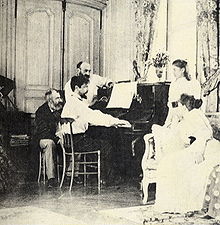music.wikisort.org - Composition
The Little Nigar (CD 122, L. 114) is the original title by composer Claude Debussy for a short piece for piano, composed in 1909 for a piano method and published the same year. It was later also published as a single piece, entitled The Little Negro and Le petit nègre. In more recent times, the piece has also been published under the title Le petit noir (The Little Black).
| The Little Nigar | |
|---|---|
| Cake Walk | |
| Piano music by Claude Debussy | |
 Debussy at the piano in 1893 | |
| Other name | The Little Negro / Le petit nègre |
| Key | C major |
| Catalogue |
|
| Composed | 1909? |
| Published |
|
History
Debussy composed The Little Nigar (giving the noun this spelling)[1] in 1909[2] on a commission from Théodore Lack, for his piano method Méthode de Piano.[3][4] The subtitle describes it as a cakewalk.[3] It is reminiscent of Golliwogg's Cakewalk from his Children's Corner, a piano suite that he had composed a year earlier. In both pieces, rhythmic outer sections frame a melodic middle section. In Golliwogg's Cakewalk, the middle section satirically quotes the beginning of Tristan und Isolde by Richard Wagner, a composer who had influenced Debussy when he was young but from whose late romantic style Debussy later distanced himself.[5]
Debussy regularly sought exotic influences. In The Little Nigar, he alluded to banjo chords and drums,[6] influenced by American minstrel shows.[4] The piece, marked allegro, begins with a first theme presenting "jazzy" syncopes in 2
4 time, in the then popular ragtime style.[7] It is followed by a lyrical passage, marked espressivo and pianissimo (very softly), which leads to a return of the first section. The first theme leans towards pentatonic and is accompanied by a chromatic sequence of broken minor thirds.[8]
The Little Nigar was first published in 1909 by Éditions Alphonse Leduc in Paris as part of Lack's piano method and again as a single piece in about 1934, now with an added repetition and entitled The Little Negro, with subtitle Le petit nègre.[3][2]
Debussy also used the piece's main theme in his 1913 ballet for children, La boîte à joujoux, in which it characterises an English soldier.[6][5]
Numerous transcriptions in various instrumentations have been made of the piece. An arrangement for woodwinds has even been used for advertising Purina One dog food.[9]
Literature
- Schmitz, E. Robert (1950). The Piano Works of Claude Debussy, foreword by Virgil Thomson. New York: Duell, Sloan & Pearce.
References
- McKinley, Ann (1986). "Debussy and American Minstrelsy". The Black Perspective in Music. JSTOR. 14 (3): 249–258. doi:10.2307/1215065. ISSN 0090-7790. JSTOR 1215065.
- "The little Nigar". Centre de documentation Claude Debussy. Retrieved 4 August 2018.
- Heinemann, Ernst-Günter. "Postface" (PDF). Henle. Retrieved 4 August 2018.
- Scheytt, Jochen (2017). "Le petit nègre". jochenscheytt.de. Retrieved 4 August 2018.
- Smith, Lindy (2008). "Out of Africa: The Cakewalk in Twentieth-Century / French Concert Music". Nota Bene: Canadian Undergraduate Journal of Musicology. 1 (1): 75–80. Retrieved 4 August 2018.
- Andres, Robert (2005). "An introduction to the solo piano music of Debussy and Ravel". BBC. Retrieved 4 August 2018.
- "The little Negro". Henle. Retrieved 4 August 2018.
- Eichmann, Andreas, ed. (2014). Kurt Weill und Frankreich (in German). Waxmann Verlag. p. 46. ISBN 978-3-83-098077-3.
- Brown, Matthew (2012). Debussy Redux: The Impact of His Music on Popular Culture. Indiana University Press. p. 5. ISBN 978-0-25-335716-8.
External links
- The Little Nigar (Debussy, Claude): Scores at the International Music Score Library Project
- The little nigar (recordings) muziekweb.nl
- Christine Stevenson: N is for Negre – Debussy’s Le Petit Negre notesfromapianist.wordpress.com 2012
- Debussy: The little nigar(Ichiro Kaneko) on YouTube
Другой контент может иметь иную лицензию. Перед использованием материалов сайта WikiSort.org внимательно изучите правила лицензирования конкретных элементов наполнения сайта.
WikiSort.org - проект по пересортировке и дополнению контента Википедии
